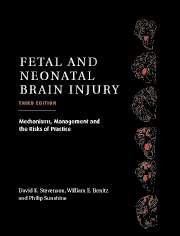Book contents
- Frontmatter
- Contents
- List of contributors
- Foreword
- Preface
- Part I Epidemiology, Pathophysiology, and Pathogenesis of Fetal and Neonatal Brain Injury
- 1 Perinatal asphyxia: an overview
- 2 Mechanisms of brain damage in animal models of hypoxia–ischemia in newborns
- 3 Cellular and molecular biology of perinatal hypoxic–ischemic brain damage
- 4 Fetal responses to asphyxia
- 5 Congenital malformations of the brain
- 6 Prematurity and complications of labor and delivery
- 7 Intrauterine growth retardation (restriction)
- 8 Hemorrhagic lesions of the central nervous system
- Part II Pregnancy, Labor, and Delivery Complications Causing Brain Injury
- Part III Diagnosis of the Infant with Asphyxia
- Part IV Specific Conditions Associated with Fetal and Neonatal Brain Injury
- Part V Management of the Depressed or Neurologically Dysfunctional Neonate
- Part VI Assessing the Outcome of the Asphyxiated Infant
- Index
- Plate section
5 - Congenital malformations of the brain
from Part I - Epidemiology, Pathophysiology, and Pathogenesis of Fetal and Neonatal Brain Injury
Published online by Cambridge University Press: 10 November 2010
- Frontmatter
- Contents
- List of contributors
- Foreword
- Preface
- Part I Epidemiology, Pathophysiology, and Pathogenesis of Fetal and Neonatal Brain Injury
- 1 Perinatal asphyxia: an overview
- 2 Mechanisms of brain damage in animal models of hypoxia–ischemia in newborns
- 3 Cellular and molecular biology of perinatal hypoxic–ischemic brain damage
- 4 Fetal responses to asphyxia
- 5 Congenital malformations of the brain
- 6 Prematurity and complications of labor and delivery
- 7 Intrauterine growth retardation (restriction)
- 8 Hemorrhagic lesions of the central nervous system
- Part II Pregnancy, Labor, and Delivery Complications Causing Brain Injury
- Part III Diagnosis of the Infant with Asphyxia
- Part IV Specific Conditions Associated with Fetal and Neonatal Brain Injury
- Part V Management of the Depressed or Neurologically Dysfunctional Neonate
- Part VI Assessing the Outcome of the Asphyxiated Infant
- Index
- Plate section
Summary
Embryonic stages and brain malformations
The central nervous system (CNS) is one of the earliest to begin development in the human embryo and does not complete maturation until several years after birth when myelination is complete. The embryonic period encompasses 23 stages that are completed approximately 2 months following fertilization. These developmental stages, frequently referred to as the Carnegie stages, provide a precise morphological framework for following development and are helpful in determining the timing of many abnormalities of the brain and spinal cord in humans. The definitive account of embryonic development was published by O'Rahilly and Müller who refined and updated previous work on the Carnegie embryo collection. Additional clarification of staging and prenatal ages has also been provided. They have recently added a detailed account of the development of the human brain during the embryonic period and this reference, along with the older work of Lemire et al., provides specific information about the development of the human CNS. Table 5.1 outlines a general framework of features related to the embryonic stages and Table 5.2 provides selected information on brain development.
A useful concept in assessing the timing of human malformations is that of a “termination period,” a point in time beyond which a specific malformation cannot occur. For example, in humans the rostral neuropore closes in embryonic stage 11. Anencephaly is felt to arise in most cases when the neuropore fails to close.
- Type
- Chapter
- Information
- Fetal and Neonatal Brain InjuryMechanisms, Management and the Risks of Practice, pp. 111 - 128Publisher: Cambridge University PressPrint publication year: 2003



